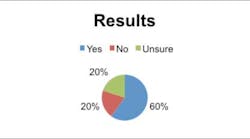Workplace wellness programs; link between type 1 diabetes and heart disease
2. No. The Affordable Care Act’s workplace wellness incentive program tied to preventive screenings could increase the likelihood of over diagnosis. I think workplace wellness programs should incentivize. (20%, 1 Votes)
3. Unsure. Workplace wellness programs are beneficial – both those tied to preventive screenings and those that incentivize healthy choices; however, there is not enough data about the costs and outcomes. (20%, 1 Votes)
A survey done by Walgreens suggests confusion among 31.5 million enrolled in Medicare Part D plans, and finds up to 50 percent are unaware of certain cost-saving opportunities. More than one-third of Medicare Part D beneficiaries surveyed (37 percent) have everyday fears about their prescription drug costs and 1 in 5 say they’ve had to make sacrifices, such as delaying filling a prescription or skipping doses, to help manage medication costs.(2,3)
Perhaps we can share this information with our senior patients and help them understand the system.
Enjoy the newsletter! World MS Day, Melanoma Monday, the new report White Out!, Nutrition, the oral-systemic link, and other items of interest are covered!
References
1. http://www.publichealthnewswire.org/?p=7453.
2. Centers for Medicare and Medicaid Services, “2013 Medicare Part D Landscape,” September 19, 2012; http://www.cms.gov/Medicare/Prescription-Drug-Coverage/PrescriptionDrugCovGenIn/. Accessed May 8, 2013.
3. http://www.pwrnewmedia.com/2013/walgreens/release/pages/fullrelease.html#fullarticle.
4. http://www.pwrnewmedia.com/2013/walgreens/release/downloads/WAL-Infographic-Horizontal.pdf.
5. http://www.pwrnewmedia.com/2013/walgreens/release/downloads/WAL_PartD_Info.pdf.
6. http://www.newswise.com/articles/view/602647/?sc=dwhn.
7. Prabhakara R. Nagareddy, Andrew J. Murphy, Roslynn A. Stirzaker, Yunying Hu, Shiquing Yu, Rachel G. Miller, Bhama Ramkhelawon, Emilie Distel, Marit Westerterp, Li-Shin Huang, Ann Marie Schmidt, Trevor J. Orchard, Edward A. Fisher, Alan R. Tall, Ira J. Goldberg. Hyperglycemia Promotes Myelopoiesis and Impairs the Resolution of Atherosclerosis. Cell Metabolism - 7 May 2013 (Vol. 17, Issue 5, pp. 695-708).
Sincerely,
Maria Perno Goldie, RDH, MS
To read previous RDH eVillage FOCUS introductions by Maria Perno Goldie, go to introductions.
To read more about the oral-systemic lnk, click here.












